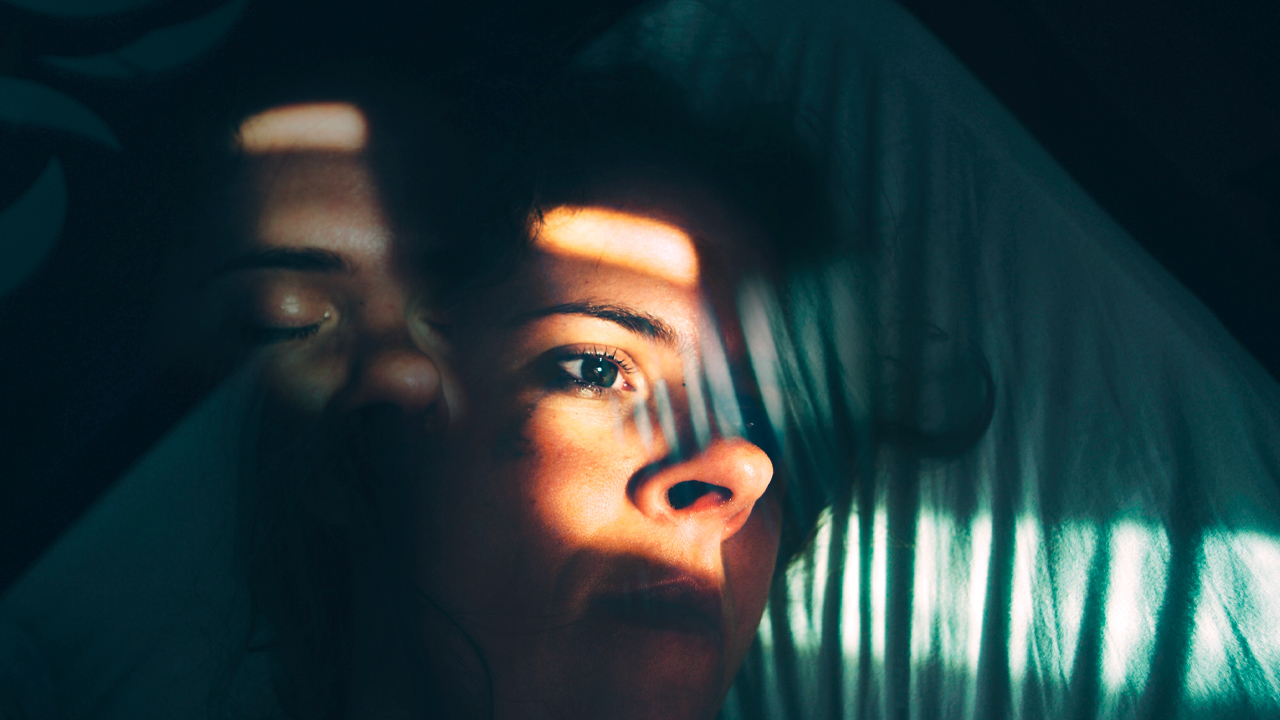“It Took Three Years For Doctors to Recognize My Breast Implant Illness”
This very real condition—with very real symptoms—is still not widely recognized by the medical community. Here's why

It was a warm fall evening as Molly flitted about, turning off the lights in the sleek downtown Toronto showroom. Cheryl, our mutual friend, and I were in the back, setting up my camera and lights while Molly’s dog, a miniature pinscher named Sir Oxford, perched shakily on a stylish sofa. When Molly was done, she sat down in a chair and took off her white T-shirt and her bra, and I snapped the first picture. She straightened her shoulders, her long, dark hair hanging in the back like a sheeny curtain. Her large green eyes stared into the camera somewhat defiantly and, not smiling, she turned her profile.
Her skin was perfect, dusted with freckles. Her breasts were perfect, too. She looked beautiful, and I told her so. Otherwise, it was almost ceremonially quiet, all three of us aware that this was not just a photo shoot, the delicate intimacy of the event due not just to the fact that one of us was topless. Yet, this was exactly about breasts—Molly’s right one, specifically, the one with cancer in it. With the photographs, Molly wanted to memorialize her body before it underwent surgery, radiation and chemotherapy, and, unbeknownst to her at the time, a whole lot more.
Two days after the shoot, Molly had two lumps and some lymph nodes removed. Her right breast was drastically altered. She was 31—cancer and hospitalization seemed absurd at our age, but it was now her reality. Molly’s ordeal would overwhelm most people: tissue expanding (radiation damages skin’s elasticity), drains, painful injections (a needle into the nipple), a bad reaction to an anaesthetic (resulting in an emergency surgery), and weekly hospital visits. But being a silver-lining type of a person, Molly joked that at least she’d get a free boob job out of the deal. And she did.
Ten years later, Molly took another picture of her body without the aid of a photographer. It was an Instagram selfie, taken at Princess Margaret Cancer Centre in Toronto. Underneath it, Molly wrote, “It is crazy to think that the real ones tried to kill me, and then the fake ones did too.”
She was four weeks past her explant surgery, and she was only just starting to improve after a three-year-long battle with Breast Implant Illness (BII), a very real condition that is, bewilderingly, still not recognized as a diagnosable medical illness by professionals. Google “BII” and you will find a handful of articles littered with words and phrases such as “anecdotal,” “self-identified,” “some women,” “wide range of symptoms” and “unverifiable.” This is how BII is described, giving the impression that it is not something to be taken seriously, or at least not something deserving of more mainstream exposure.
Unfortunately, even when BII gets attention it’s problematic, according to one source saying, “The recent increase in patients reporting Breast Implant Illness (BII) symptoms appears to be related to social media(…) This is not to say that social media is the cause of Breast Implant Illness (BII); however, it may account for the rapid increases in patient reporting.” Indeed, most of the discussion is confined to social media groups where thousands of women talk about their experiences with breast implants making them sick.
So, what is Breast Implant Illness?
In 2018, there were more than 50,000 women reporting BII symptoms. By 2020, Facebook groups can easily count twice as many. The symptoms mimic those of autoimmune and/or connective tissues disorders such as lupus, which means fatigue, memory loss and joint pain. The most specific connection between implants and illness is that of a form of T-cell lymphoma (cancer of the immune system) called breast implant-associated anaplastic large cell lymphoma (BIA-ALCL).
The symptoms of BII can appear as early as six months but then there are reports of women who haven’t had any issues for years only to suddenly develop a plethora of symptoms. These irregularities only add to the confusion of how to define and treat this illness. In Molly’s case, for example, a few years passed before she started noticing peculiar symptoms, such as pain in her feet. It was severe enough that she went to foot specialists, started wearing “sensible shoes” and spent a “crazy amount of money” on tests and dubious cures (including ice socks).
“Throughout this, my doctors…I don’t want to say they didn’t care, but that’s how it felt to me. I could just tell something wasn’t right. And then it went into my hands. Or I would wake up, and one of my knees would get locked, and I would literally have to just pull it to bring it up. I couldn’t get out of bed. I had a pair of slippers beside my bed, and I would just have to sort of shimmy my feet if I got up in the middle of the night to go to the bathroom.”
Then it was her wrists, her arms, elbows. (She joked to her doctor she had a “vacuum elbow” from vacuuming too much—and she later found out, to her surprise, this was noted in her medical records as if it were an actual condition.) Her skin dulled, and she says even her eyes got smaller. Then there was brain fog: “I remember saying to one of my doctors, ‘I know I was in to see you last week. I honestly, I can’t remember what we talked about.’” That doctor and other doctors remained baffled.
Finally, Molly’s mom suggested BII—she had read about it in an online article. She kept asking Molly what kind of implants she had. Molly never bothered to check; it wasn’t on the list of priorities amidst all the medical chaos. But there was an implant type—Biocell textured breast implants—linked to anaplastic large cell lymphoma (BIA-ALCL). On June 1, 2020, Allergan Canada launched a multi-channel campaign to contact patients who may not have been aware of the July 24, 2019 recall of the implant.
Molly didn’t know if she had the textured implant, but she knew that out of 20 of the symptoms common in BII, she had 18. “So I went to my surgeon and told her that I was experiencing all of these. I had major auto-immune issues and major cognitive issues. And when I asked my surgeon, ‘If I was your sister, would you tell me to remove my implants?’ she said, ‘don’t jump into any conclusions.’” The doctor told Molly to wait. Then Molly went for her annual MRI check-up. Shortly after, while on vacation in Portugal with her fiancée, she got a call from the hospital, saying one of her implants had ruptured, the toxic silicone leaking into her lymph nodes.
Will the medical community ever recognize BII as legitimate?
Dr. Tim Sayed, a San Diego-based plastic surgeon recommended by one of those Facebook groups, says “to date, we haven’t determined or found a replicable pathway that you could analyze in the laboratory environment to explain the presence of the symptoms.” Having said that, Dr. Sayed recognizes BII as a genuine condition and, for the past 10 years, has been specializing in explant surgery. He says he hates that some of his colleagues believe BII is a psychosomatic problem. “Is it possible that at some critical mass in a susceptible patient implant induces an inflammatory reaction? Is it possible that in some people, implants trigger some other systemic symptoms? My observation is that it is, although that’s not the official position of the plastic surgery community.”
It’s clear to him, he says, from his own experience treating women that those who had BII and a variety of symptoms showed significant improvement after having their implants removed. He says how in only six weeks, a woman who’d arrive in his office scared, sick and depressed, could make a 180 after explant surgery, and show up at the follow-up looking bright, and full of energy and smiles. “I can’t objectively put the finger on exactly what it was biologically that is making her feel better. I just know that she had an explant that I did, and this is a new person, and that’s my bias, in terms of the quality of life improvements.”
Today, 80% of procedures performed at Dr. Sayed’s practice are explant surgeries. He acknowledges that there isn’t enough information out there, and women often visit multiple doctors before showing up at his office to ask him to intervene. The biggest difficulty with BII, according to Dr. Sayad and other medical professionals, is that the symptoms are so wide-ranging and almost impossible to replicate in order to pinpoint the exact cause and course of treatment. However there is hope. A new study released in July, “Understanding Breast Implant Illness, Before and After Explantation” in the Annals of Plastic Surgery, showed significant health improvements—no more aches, memory and hair loss, skin irritation, and so on—30 days (and beyond) after breast implant removal among 752 patients. The hypothesis is that it was the foreign object (the implant) that triggered the symptoms and the silicone that accounted for inflammation. Future investigation is recommended by the study to further explain “possible biologic phenomena to better characterize the pathophysiology and mechanism of BII.”
Here in Canada, after getting a petition from women concerned with their implants, Health Canada has formed the Scientific Advisory Committee (SAC) on Women’s Health designed to address, among other items, issues related to breast implants. They have also “initiated another safety review focusing on systemic symptoms such as rheumatic and autoimmune disorders” and have acknowledged the significant risk of macro-textured implants. The official response to the petition is, “Health Canada will take prompt action and will inform healthcare professionals and the public if there are changes to the safety of breast implants.”
Molly had her implants removed in December 2019, followed by weeks of drains, tubes and bandages. She decided not to get the supposedly safer saline implants after researching more about BII—it seemed no implant was safe, women with implants different from hers were still experiencing BII. Understandably, Molly had had enough of risks and dubious surprises: She had seen her doctor only six months prior, when the Allergen recall was already underway. She says, “There’s no way [my doctor] didn’t know that this was in the works.” She says she feels conflicted about being angry with her medical team as they were instrumental in her recovery from cancer but, “at the same time, I feel like I was hugely let down because they didn’t take [my BII symptoms] seriously. The years building up to this where I kept saying something’s wrong. There’s something wrong.”
Today, Molly’s recovery is remarkable. She exercises again, her skin is bright, her feet and elbows no longer hurt, her period is back. She says her memory feels clear, there’s no more brain fog. One thing is still missing, however: “Throughout all of this, I didn’t have one doctor in my personal network who has said, ‘yes, what you were experiencing is, in fact, Breast Implant Illness. Like, they’re still in denial.”









